Special tool
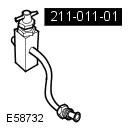 211-011-01 Valve Block, Power Steering Pressure Test 211-011-01 Valve Block, Power Steering Pressure Test | 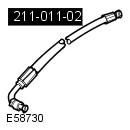 211-011-02 Hose, Power Steering Pressure Test 211-011-02 Hose, Power Steering Pressure Test |
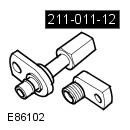 211-011-12 Adapter, Power Steering Pressure Test 211-011-12 Adapter, Power Steering Pressure Test | 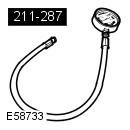 211-287 Hose and Gauge, Power Steering Pressure Test 211-287 Hose and Gauge, Power Steering Pressure Test |
1. Disconnect the battery ground wire. Refer to procedure: Specifications (414-00 Charging system - General information, Specifications).
2. Remove the engine cover. Refer to Procedure: Engine Cover - 2.2L Duratorq - Td4 (501-05 Interior trim, Removal and installation).
3. Raise the vehicle.
WARNING: Place secure stands under the vehicle.
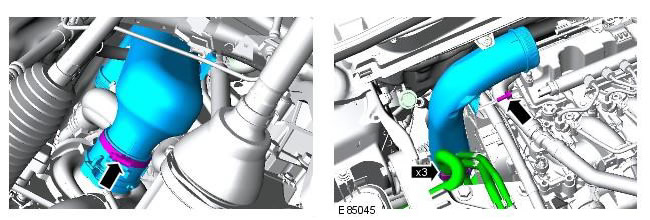
4. Remove and discard two wire ties.
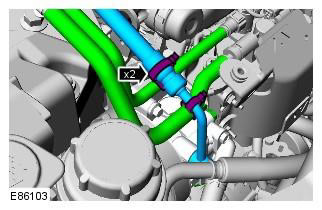
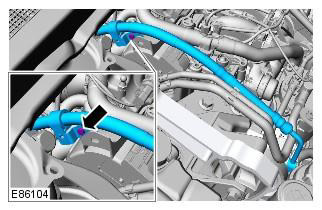
5. Pump out a working liquid from a tank of the amplifier of a steering.
WARNING: Dispose of fluid leaking from the power steering.
6. Lay down an absorbent cloth to soak up spilled fuel.
7. Disconnect the power steering high pressure pipe.
CAUTION: Before disconnecting or removing components, clean the area around contact surfaces and connections. Always support the vehicle with jack stands.
NOTE: During this operation, some liquid will inevitably spill out.
NOTE: Be careful not to contaminate the accessory drive belt.
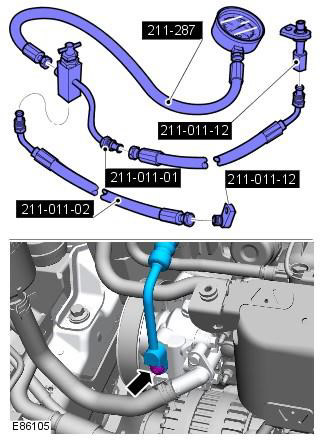
8. Install the O-ring.
9. Install the special tool. Special tool: 211-011-12, 211-011-02, 211-011-02, 211-011-01, 211-287
10. Tie a pressure gauge to the side under the hood.
11. Fill fluid into the power steering system and bleed air from the system. Refer to Procedure: Bleeding Power Steering System (211-00 Steering system - General information, General procedures).
CAUTION: Use only fresh fluid from a sealed container.
12. Connect the wire "masses" to the battery.
13. Start the engine with the check valve open.
NOTE: Check steering controls and test equipment for leaks.
NOTE: Maintain the maximum fluid level while performing the check.
NOTE: Make sure the steering system is installed straight ahead.
14.
- Turn the steering wheel from one extreme position to another, turn off the engine.
- Add working fluid to the power steering reservoir.
15. Refer to Power Steering Specifications section for power steering system pressures. Refer to procedure: Specifications (211-02 Power Steering, Specifications).
16.
- With the engine running at idle, turn the steering wheel and hold it fully.
- Record the pressure reading.
- Repeat the above procedure on the other side.
- Record the pressure reading.
WARNING: Do not hold the steering wheel in the end position for more than 10 seconds.
17. With the engine running at idle, release the steering wheel. The pressure must not exceed the set value.
18. If the pressure is outside the specified range, this indicates a malfunction.
19. To determine which component is faulty, the steering pump or steering rack, close the test valve for no more than 5 seconds.
CAUTION: If the test valve is closed for an extended period of time, the pump may be damaged.
20. If the measured pressure values are outside the mentioned range, then the hydraulic booster pump must be replaced.
21. If the maximum pressure of the pump is correct, look for a malfunction in the steering rack.
22. Upon completion of the test, turn off the engine, disconnect the wire "masses" battery and drain fluid from the power steering reservoir.
WARNING: Dispose of fluid leaking from the power steering.
23. Disassemble the equipment for testing.
- Clean the contact surfaces of the elements.
- Install a new O-ring.
- Connect the high pressure line to the power steering pump. Tightening torque: 22 Nm
24. Install the power steering high pressure pipe support bracket.
25. Secure the fuel lines to the power steering high pressure lines with new clamps.
26. Install the turbocharger inlet pipe.
27. Replace the engine top cover. Refer to Procedure: Engine Cover - 2.2L Duratorq - Td4 (501-05 Interior trim, Removal and installation).
28. Connect the wire "masses" to the battery. Refer to procedure: Specifications (414-00 Charging system - General information, Specifications).
29. Fill fluid into the power steering system and bleed air from the system. Refer to Procedure: Bleeding Power Steering System (211-00 Steering system - General information, General procedures).
CAUTION: Use only fresh fluid from a sealed container.
Comments on this article